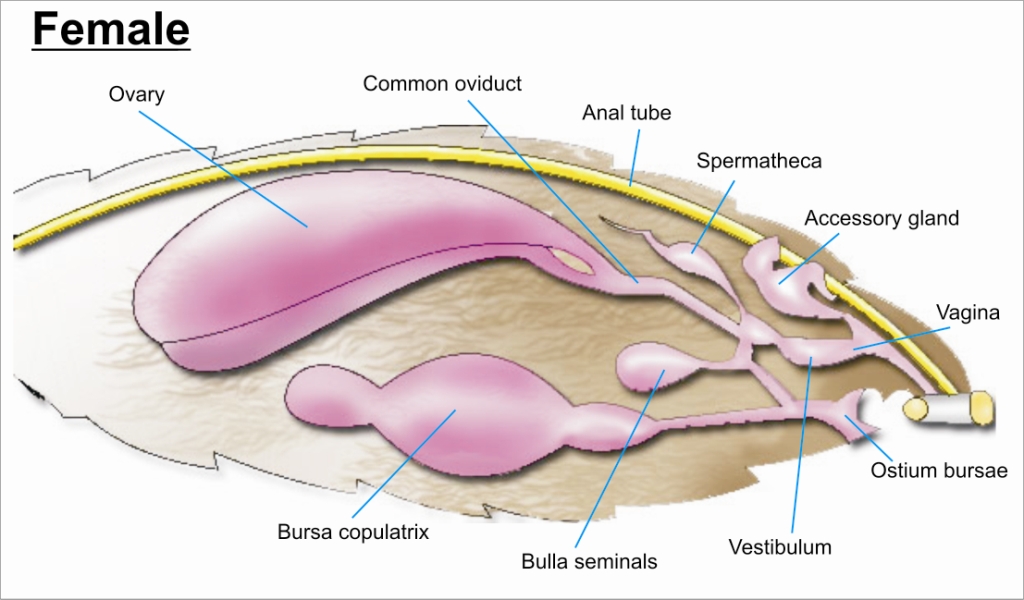|
Parameres
Parameres ('side parts') are part of the external reproductive organs of male insects and the term was first used by Verhoeff in 1893 for the lateral genital lobes in Coleoptera. The primary phallic lobes which appear in the nymph or larval stages may become a pair of penes in the Ephemeroptera or a simple median penis in the Thysanura. In higher insect orders from Orthoptera to Hymenoptera, each of the primary lobes is divided into two secondary lobes or phallomeres, termed parameres and mesomeres (NB: this use of the term "mesomere" is not to be confused with the same term in segmentation embryology.) In adult insects parameres may elongate and become genital claspers. These claspers may themselves occur in two segments, forming a proximal basimere and a distal telomere A telomere (; ) is a region of repetitive nucleotide sequences associated with specialized proteins at the ends of linear chromosomes (see #Sequences, Sequences). Telomeres are a widespread genetic featu ... [...More Info...] [...Related Items...] OR: [Wikipedia] [Google] [Baidu] |
Segmentation (biology)
Segmentation in biology is the division of some animal and plant body plans into a linear series of repetitive segments that may or may not be interconnected to each other. This article focuses on the segmentation of animal body plans, specifically using the examples of the taxa Arthropoda, Chordata, and Annelida. These three groups form segments by using a "growth zone" to direct and define the segments. While all three have a generally segmented body plan and use a growth zone, they use different mechanisms for generating this patterning. Even within these groups, different organisms have different mechanisms for segmenting the body. Segmentation of the body plan is important for allowing free movement and development of certain body parts. It also allows for regeneration in specific individuals. Definition Segmentation is a difficult process to satisfactorily define. Many taxa (for example the molluscs) have some form of serial repetition in their units but are not conventi ... [...More Info...] [...Related Items...] OR: [Wikipedia] [Google] [Baidu] |
Insect Genitalia
Most insects reproduce oviparously, i.e. by laying eggs. The eggs are produced by the female in a pair of ovaries. Sperm, produced by the male in one testicle or more commonly two, is transmitted to the female during mating by means of external genitalia. The sperm is stored within the female in one or more spermathecae. At the time of fertilization, the eggs travel along oviducts to be fertilized by the sperm and are then expelled from the body ("laid"), in most cases via an ovipositor. Internal Female Female insects are able to make eggs, receive and store sperm, manipulate sperm from different males, and lay eggs. Their reproductive systems are made up of a pair of ovaries, accessory glands, one or more spermathecae, and ducts connecting these parts. The ovaries make eggs and accessory glands produce the substances to help package and lay the eggs. Spermathecae store sperm for varying periods of time and, along with portions of the oviducts, can control sperm use. The ducts and ... [...More Info...] [...Related Items...] OR: [Wikipedia] [Google] [Baidu] |
Harpago
''Harpago'' is a genus of sea snails, marine (ocean), marine gastropoda, gastropod mollusca, mollusks in the family (biology), family Strombidae, the true conchs. Harpago ('grappling iron') is also a term used in insect morphology for the distal end of a genital clasper. Species Species within the genus ''Harpago'' include: References Strombidae Gastropod genera {{Strombidae-stub ... [...More Info...] [...Related Items...] OR: [Wikipedia] [Google] [Baidu] |

